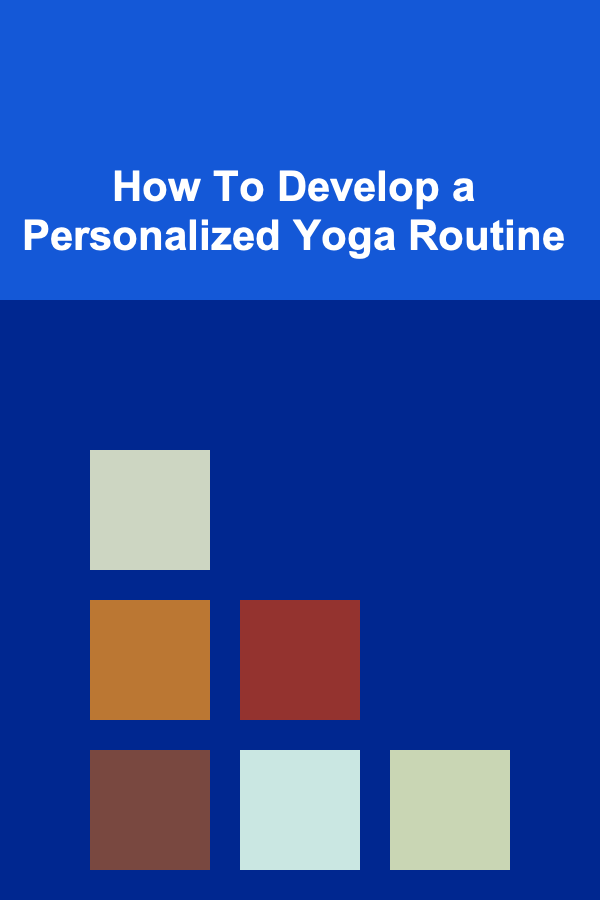
How To Develop a Personalized Yoga Routine
ebook include PDF & Audio bundle (Micro Guide)
$12.99$11.99
Limited Time Offer! Order within the next:

Yoga has long been celebrated for its mental, physical, and spiritual benefits. From reducing stress to improving flexibility and strength, yoga is an empowering practice that offers a holistic approach to wellness. However, finding the right routine that works for your body and mind can sometimes feel overwhelming, especially with so many styles and techniques to choose from. Developing a personalized yoga routine tailored to your unique goals, preferences, and abilities is a great way to make the practice more effective and enjoyable. In this guide, we will explore how to design a personalized yoga routine that aligns with your needs.
Understanding the Basics of Yoga
Before jumping into the process of creating a personalized yoga routine, it's essential to understand the foundation of yoga. At its core, yoga is more than just physical postures (asanas). It is a practice that integrates the body, mind, and spirit through various tools, including breathwork (pranayama), meditation, and mindful movement.
The Components of Yoga
- Asanas (Postures): The physical exercises and movements that build strength, flexibility, and balance.
- Pranayama (Breath Control): Techniques designed to regulate the breath, which enhances mental clarity, calmness, and energy flow.
- Meditation: A practice to calm the mind, increase focus, and enhance mindfulness.
- Mantras: Repeating words or sounds to induce focus, positive energy, and mental clarity.
- Mudras: Hand gestures used to direct the flow of energy in the body.
When developing a personalized yoga routine, it is important to consider how each of these components can be incorporated to achieve balance and alignment in your practice.
Assessing Your Current Fitness Level and Goals
The first step in developing a personalized yoga routine is assessing your current fitness level and defining your goals. Everyone's body is different, so the ideal yoga routine will vary from person to person. Understanding your strengths, limitations, and objectives will help you craft a plan that suits your needs.
Fitness Level
Evaluate your current physical fitness to determine which aspects of yoga need more focus. For instance:
- Flexibility: Do you have tight muscles or limited range of motion?
- Strength: Are you looking to build more strength, especially in areas like your core, arms, or legs?
- Balance: Do you struggle with stability in poses?
- Endurance: Are you looking to build stamina and energy for more advanced poses or longer sessions?
By recognizing your current level, you can choose asanas that match your abilities and gradually challenge yourself to grow.
Goals
Next, consider what you want to achieve through your yoga practice. Common goals include:
- Stress Relief: If your primary goal is to reduce stress, a slower, more restorative practice with a focus on deep breathing may be beneficial.
- Increased Flexibility: If you're aiming to increase flexibility, incorporating more poses that stretch major muscle groups is essential.
- Strength and Muscle Tone: A focus on more active postures and flow-based sequences can help build strength, especially in areas like the arms, legs, and core.
- Mindfulness and Meditation: If your goal is to cultivate mental clarity and focus, incorporating pranayama and seated meditation will support your practice.
- Pain Relief: If you're dealing with chronic pain or injury, focusing on gentle, rehabilitative movements might be key to a sustainable practice.
Clearly defining your goals will guide your choices of poses, breath techniques, and the overall style of your practice.
Choosing the Right Yoga Style
Yoga comes in a variety of styles, each with its unique focus and approach. Here are some popular yoga styles to consider when developing your personalized routine:
Hatha Yoga
A gentle, slower-paced style that focuses on basic postures and relaxation techniques. Hatha yoga is great for beginners or anyone looking to improve flexibility, strength, and mindfulness in a calm and steady way.
Vinyasa Yoga
Vinyasa yoga is characterized by a dynamic flow of movement that is synchronized with the breath. This style emphasizes fluid transitions between poses and is excellent for building strength, flexibility, and endurance. It's a great option if you're looking for an active practice with a focus on coordination and balance.
Ashtanga Yoga
A rigorous and structured style that involves a set sequence of postures performed in a specific order. Ashtanga is ideal for individuals seeking a more intense, physically challenging practice that builds strength, flexibility, and focus.
Iyengar Yoga
Iyengar yoga focuses on precision and alignment in the postures. It often uses props like blocks, straps, and blankets to help practitioners achieve correct form. This style is suitable for those looking for a detail-oriented practice that emphasizes safety and alignment.
Restorative Yoga
This style of yoga is designed to promote relaxation and healing through supported poses. Restorative yoga uses props to help the body relax deeply, and it's perfect for individuals looking to reduce stress, recover from injury, or simply restore balance.
Yin Yoga
Yin yoga involves holding passive poses for extended periods (typically 3-5 minutes). It focuses on deep stretching and the release of tension in the connective tissues. This style is helpful for increasing flexibility and cultivating mindfulness.
Kundalini Yoga
Kundalini yoga combines postures, breathwork, chanting, and meditation to awaken the "Kundalini energy" believed to reside at the base of the spine. This style is ideal for those looking to explore spiritual and energetic aspects of yoga.
The style you choose should align with your personal goals, fitness level, and preference. You can mix and match different styles in your routine to achieve a balanced practice.
Designing Your Yoga Routine
Once you've assessed your fitness level, set goals, and chosen a style, it's time to design your personalized yoga routine. Here are some key considerations when developing your practice:
Duration and Frequency
Consider how much time you can realistically dedicate to your yoga practice. If you're new to yoga, starting with 20-30 minute sessions a few times a week is a good place to begin. As you become more comfortable, you can gradually increase the duration and frequency of your sessions.
For example:
- Beginners: 20-30 minutes, 3-4 times a week
- Intermediate: 45-60 minutes, 4-5 times a week
- Advanced: 60-90 minutes, 5-6 times a week
Consistency is key, but it's essential to listen to your body and avoid overexertion. Rest and recovery are just as important as practice.
Warm-up and Cool-down
A well-rounded yoga routine should always include a warm-up and cool-down. Warming up prepares your body for the physical demands of yoga, while cooling down allows your body to relax and recover.
- Warm-up: Start with gentle stretches or breathing exercises to warm up the body. Sun Salutations (Surya Namaskar) are often used as a warm-up to build heat and energy.
- Cool-down: End your practice with gentle stretching, restorative poses, and pranayama to bring your body back to a state of calm.
Balancing Strength and Flexibility
A personalized yoga routine should have a balance of poses that work on both strength and flexibility. For example:
- Strength Poses: Plank, Warrior poses, Downward Dog, Chair pose, and Boat pose are great for building strength.
- Flexibility Poses: Forward bends, hip openers, and twists help improve flexibility and mobility.
For a well-rounded practice, include poses that work on all major muscle groups and ensure you're stretching and strengthening your entire body.
Incorporating Pranayama and Meditation
Breathwork (pranayama) and meditation are crucial elements of a personalized yoga routine. Breath control enhances the mind-body connection and helps reduce stress.
- Pranayama Techniques: Try practicing deep belly breathing, alternate nostril breathing (Nadi Shodhana), or Kapalbhati (skull shining breath) to energize or calm your system.
- Meditation: Conclude your practice with a few minutes of seated meditation or mindful breathing to center yourself and cultivate a sense of inner peace.
Modifying Poses for Your Body
If you have specific injuries or limitations, be sure to modify poses to suit your body's needs. Use props such as yoga blocks, straps, and cushions to support your practice. Don't push your body beyond its current capacity---listen to your body and make adjustments accordingly.
Tracking Progress and Adjusting Your Routine
As you continue with your personalized yoga routine, it's important to track your progress and make adjustments as necessary. Regular self-reflection can help you identify areas of improvement and areas that need more attention.
- Keep a Yoga Journal: Document your experiences, including how you feel before and after each session. Track any physical or emotional changes you notice over time.
- Assess Your Goals: Periodically assess your goals and determine if you need to adjust your routine. If flexibility is your primary goal, consider adding more stretches or incorporating longer holds. If strength is your focus, include more dynamic poses that challenge your muscles.
Remember that yoga is a lifelong practice, and progress comes at its own pace. Celebrate small achievements and be patient with yourself.
Conclusion
Developing a personalized yoga routine is a deeply empowering process. By assessing your fitness level, setting clear goals, and choosing the right style, you can create a yoga practice that is uniquely suited to your needs. As you progress, remember that yoga is not just about the physical postures---it's about cultivating a deeper connection between your body, mind, and spirit. Whether you're looking to improve flexibility, build strength, reduce stress, or simply find inner peace, yoga offers a transformative journey toward well-being. Keep practicing, stay patient, and enjoy the process of discovering your own personalized yoga path.

How to Handle Office Supplies Wisely to Avoid Waste
Read More
How to Use Color Psychology in Your Home Renovation
Read More
The Brand Manager's Playbook: Essential Tactics for Brand Positioning and Success
Read More
Why Using Multi-Purpose Rooms Maximizes Space Efficiency
Read More
Understanding Humor Across Cultures: A Deep Dive
Read More
Selecting the Best Bearing Press Set for Bottom Brackets and Hubs
Read MoreOther Products

How to Handle Office Supplies Wisely to Avoid Waste
Read More
How to Use Color Psychology in Your Home Renovation
Read More
The Brand Manager's Playbook: Essential Tactics for Brand Positioning and Success
Read More
Why Using Multi-Purpose Rooms Maximizes Space Efficiency
Read More
Understanding Humor Across Cultures: A Deep Dive
Read More